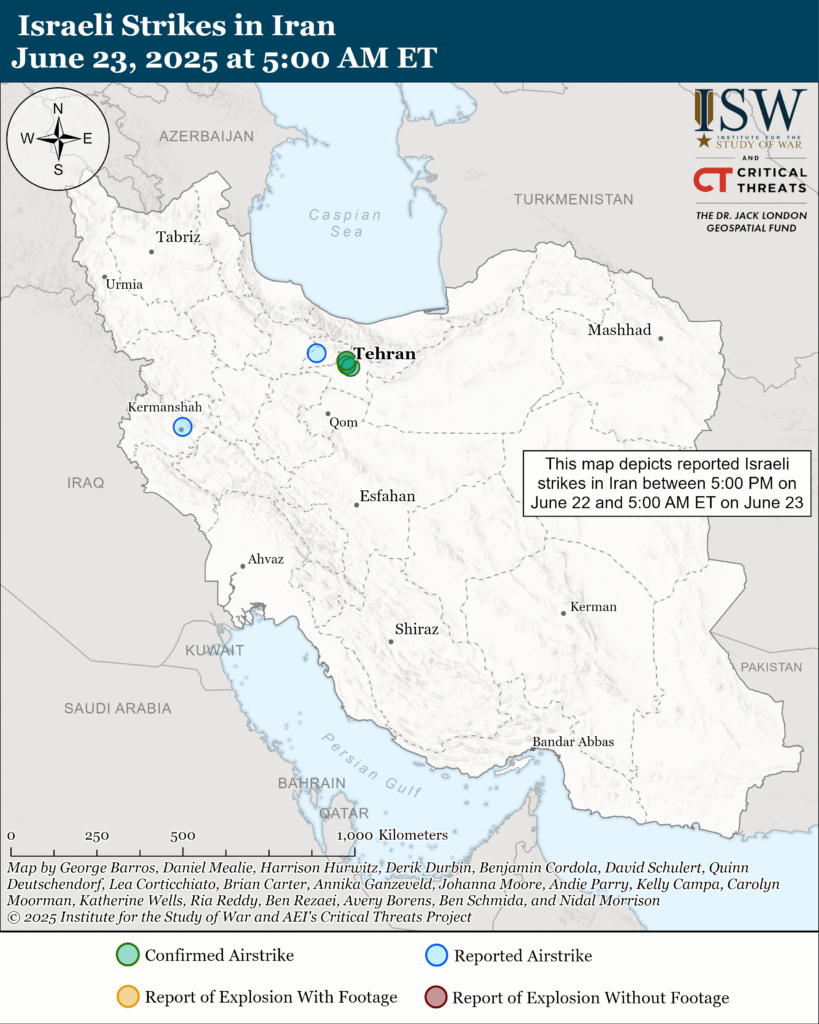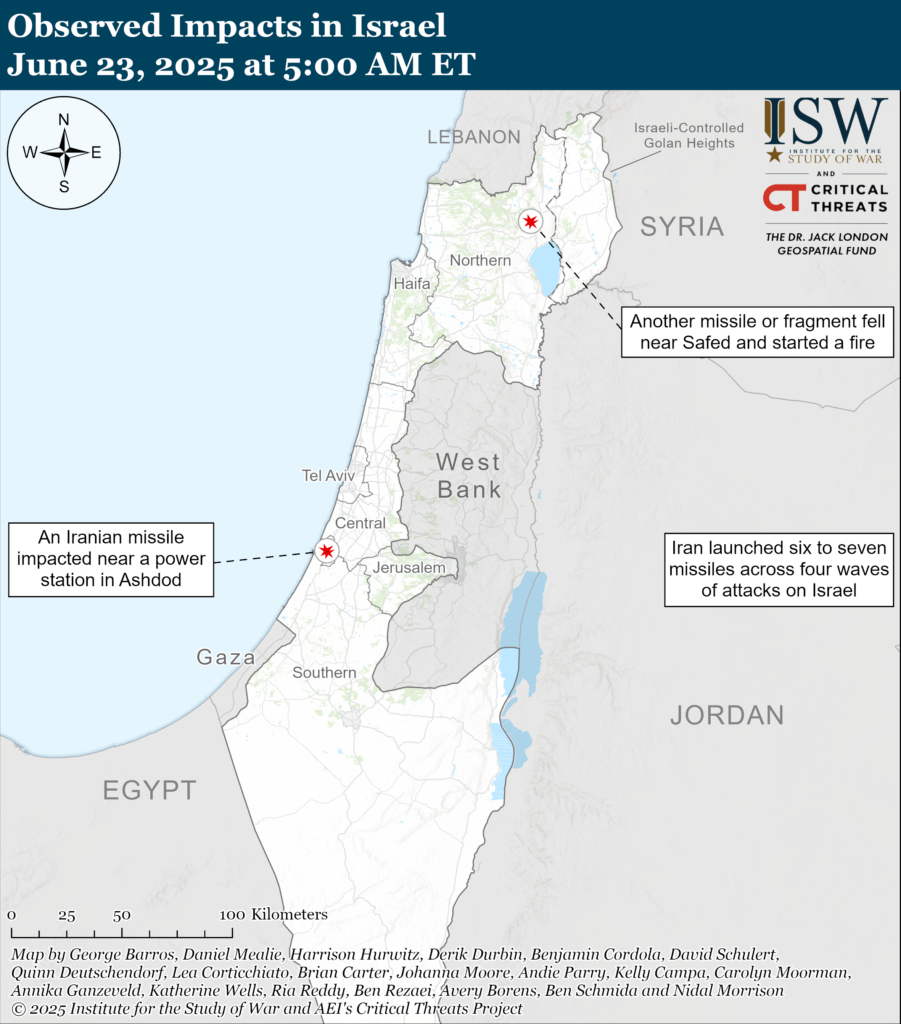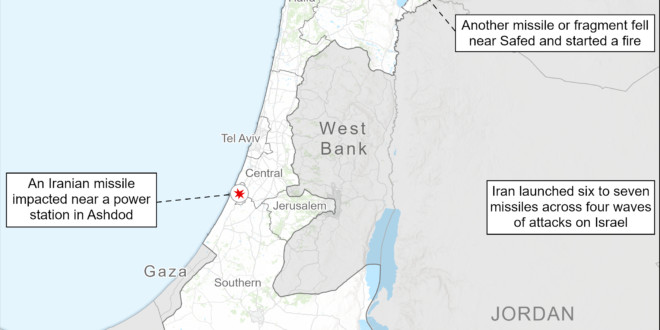NOTE: CTP-ISW is tracking early reports of Iranian missile attacks on US forces in Qatar and Iraq at the time of this publication. CTP-ISW will cover these events in our evening edition. We have published an assessment of Iran’s calculus and response options here.
Key Takeaways
The Israeli Air Force (IAF) conducted airstrikes on June 23 targeting roads leading to the Fordow Fuel Enrichment Plant (FFEP) in order to “disrupt” access to the site. Israeli strikes on access roads to Fordow may prevent Iran from being able to assess damage at Fordow or move materials from the site to another location.
The Israel Defense Forces (IDF) has continued to target Iranian internal security and social control institutions in Tehran. The IDF targeted the Basij headquarters in Tehran. The IDF also struck Evin Prison, which is Iran’s primary facility for holding regime dissidents. An Israeli Army Radio correspondent reported that the IDF struck the prison’s entrances to facilitate the escape of regime dissidents.The Israeli Air Force (IAF) conducted airstrikes on June 23 targeting roads leading to the Fordow Fuel Enrichment Plant (FFEP) in order to “disrupt” access to the site.[6] These strikes mark the first time that CTP-ISW has recorded Israeli airstrikes targeting access roads to Fordow. The IDF struck air defenses that protected Fordow during the initial days of the Israeli air campaign.[7] The Israeli strikes on access roads come after the United States struck Fordow with bunker-buster bombs on June 21.[8] The chairman of the US Joint Chiefs of Staff stated that Fordow, Natanz, and an unspecified nuclear facility in Esfahan sustained “extreme damage” from the US strikes.[9] Israeli officials echoed this statement but noted that the Fordow nuclear facility was “not destroyed.”[10] Israeli strikes on access roads to Fordow may prevent Iran from being able to assess damage at Fordow or move materials from the site to another location. Israeli officials told the New York Times on June 22 that Iran may have moved materials and equipment from Fordow ahead of the US strikes.[11]

The IDF has continued to target Iranian internal security and social control institutions in Tehran. The IDF targeted the Basij headquarters in Tehran.[12] The Basij is a paramilitary organization that recruits and organizes regime loyalists and uses them to produce and disseminate propaganda, suppress internal dissent, and conduct civil defense operations.[13] The IDF previously targeted the Basij headquarters in Esfahan on June 17.[14] The IDF also struck Evin Prison, which is Iran’s primary facility for holding regime dissidents.[15] An Israeli Army Radio correspondent reported that the IDF struck the prison’s entrances to facilitate the escape of regime dissidents.[16] Iranian media reported that Israeli airstrikes damaged a power feeder in Evin District, causing a power outage in the area.[17] An open-source watcher reported that the IDF targeted the Islamic Republic of Iran Broadcasting (IRIB) headquarters, a state-controlled media outlet that the regime uses to disseminate propaganda.[18] The US Treasury sanctioned IRIB and added it to the Specially Designated National (SDN) list in 2013.[19] The IDF previously targeted the IRIB headquarters on June 16.[20]
There are unverified reports of Israeli airstrikes targeting the Tehran Power Distribution Company and a building at or near the Energy Ministry.[21] Electricity disruptions, particularly during hot summer temperatures, could fuel internal unrest and stoke protests, which could in turn threaten regime stability.
The IDF targeted the Islamic Revolutionary Guards Corps (IRGC) Ground Forces Sarallah Operational Base and other IRGC headquarters in Tehran.[22] The Sarallah Operational Base is responsible for security in Tehran and oversees the 10th Seyyed ol Shohada Operational Division in Karaj, Alborz Province, and the 27th Mohammad Rasoul Ollah Operational Division in Tehran City.[23] The headquarters has historically played a significant role in suppressing internal dissent.[24] An Israeli Army Radio correspondent reported that the IDF estimates that it killed many IRGC personnel in its recent strikes on IRGC facilities, given that the IDF did not issue evacuation warnings ahead of the strikes.[25]
The IDF struck military infrastructure in Tehran. The IDF struck a surface-to-air missile launcher in the “heart of Tehran.”[26] CTP-ISW is monitoring additional reports of IDF strikes in Tehran after its 5:00 AM ET data cutoff for this update. CTP-ISW will cover these strikes in its June 23 evening update.

The IDF conducted a series of airstrikes in western Iran on June 22 targeting missile launchers, missile storage facilities, and satellite and radar sites.[27] The IDF said that it struck positions in Kermanshah and Hamedan.[28]

Iran has conducted at least four ballistic missile attacks targeting Israel since CTP-ISW’s last data cutoff at 5:00 PM ET on June 22.[29] An Israeli military correspondent reported that Iran fired six or seven missiles across four waves of attacks, citing IDF assessments.[30] An Iranian missile impacted near a power station in Ashdod.[31] A missile or fragment fell near Safed and started a fire.[32] The attacks did not cause any injuries or casualties.
The IAF intercepted a drone near Eilat before it entered Israeli airspace.[33]

 Eurasia Press & News
Eurasia Press & News


